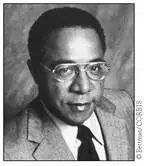I got up as George took his seat, and going over, looking at Dad, I said to the people that being the oldest child, I could remember things farther back about the gentleman lying there. For instance, my first distinct boyhood impression of love was noticing how Dad’s and Mama’s eyes would look at each other over the pianotop when Mama was playing some little introduction as Dad stood near waiting to sing in our church. Another early memory was of how I could always get a nickel or even a dime from Dad, no matter how tight people were going around saying things were. All I had to do was catch him alone and start begging him to tell me just one more time about how his AEF 92nd Division, 366th Infantry, fought in the Meuse Argonne Forest. “Why, we were ferocious, son!” Dad would exclaim. By the time he gave me the dime it was clear that whenever things would look really grim to General Blackjack Pershing, once again he would send a courier to bring Savannah, Tennessee’s, Sargeant Simon A. Haley (No. 2816106), whereupon the lurking German spies sped that news to their highest command, throwing fright into the Kaiser himself.
But it seemed to me, I told the people, that after Dad’s having met Mama at Lane College, his next most fateful meeting for all of us had been when Dad had transferred to A&T College in Greensboro, North Carolina, and was about to drop out of school and return home to sharecrop, “Because, boys, working four odd jobs, I just never had time to study.” But before he left, word came of his acceptance as a temporary summer-season Pullman porter. On a night train from Buffalo to Pittsburgh, at about 2 A.M. his buzzer rang, and a sleepless white man and his wife each wanted a glass of warm milk. Dad brought the milk, he said, “and I tried to leave, but the man was just talkative and seemed surprised that I was a working college student. He asked lots of questions, then he tipped well in Pittsburgh.” After saving every possible cent, when Dad returned to college that September of 1916, the college president showed him correspondence from the man on the train—a retired Curtis Publishing Company executive named R. S. M. Boyce—who had written asking the cost of one full year’s everything, then had sent his check. “It was about $503.15 with tuition, dormitory, meals, and books included,” Dad said, and he scored marks that later saw him win a graduate-study scholarship that the Cornell University School of Agriculture began giving that year to the top agricultural student at each of the Negro land-grant colleges.
And that, I told the people, was how our dad got his masters degree at Cornell, and then was a professor, so that we, his children, grew up amid those kinds of influences, which when put together with what a lot of other people on our mama’s side also had done, was why we were fortunate enough to be there seeing Dad off now with me as an author, George as an assistant director of the United States Information Agency, Julius as a U. S. Navy Department architect, and Lois as a teacher of music.
We flew Dad’s body then to Arkansas, where a second ceremony was thronged with his friends from Pine Bluff’s AM&N University and its area where as the dean of agriculture, Dad had rounded out his total of forty years of educating. As we knew he would have wanted, we drove him through the campus and twice along the road where the street sign near the agricultural building said “S. A. Haley Drive,” as it had been named when he retired.
The Pine Bluff service over, we took Dad to where he had previously told us he wanted to lie—in the Veterans’ Cemetery in Little Rock. Following his casket as it was taken to Section 16, we stood and watched Dad lowered into grave No. 1429. Then we whom he had fathered—members of the seventh generation from Kunta Kinte—walked away rapidly, averting our faces from each other, having agreed we wouldn’t cry.
So Dad has joined the others up there. I feel that they do watch and guide, and I also feel that they join me in the hope that this story of our people can help to alleviate the legacies of the fact that preponderantly the histories have been written by the winners.
(1921-1992)

A BIOGRAPHY
Alexander Murray Palmer Haleywas born in Ithaca, New York, on August 11, 1921. The oldest of three sons (George and Julius Haley), Haley was born to Simon and Bertha (Palmer) Haley. He grew up in the South in an African-American family also mixed with Irish and Cherokee ancestry. Haley’s father, Simon, was a professor of agriculture who had also served in World War I. Haley always spoke proudly of his father and the incredible obstacles of racism he had overcome.
At the age of fifteen, Alex graduated from high school. He attended Elizabeth City Teachers College for two years and on May 24, 1939, he began his twenty-year service with the Coast Guard. He enlisted as a seaman and then became a third-class petty officer in the rate of mess attendant, one of the few enlisted designators open to African-Americans at that time. It was during his service in the Pacific Theater of Operations that Haley taught himself the craft of writing stories.
After World War II, Haley was able to petition the Coast Guard to allow him to transfer into the field of journalism. By 1949, he had become a first-class petty officer in the rate of chief journalist. He then rose to chief petty officer until his retirement from the Coast Guard in 1959. Alex Haley was the first and only person to receive an honorary degree from the Coast Guard Academy, presented by President George H. W. Bush, and he had the singular honor of having a Coast Guard Cutter named after him. Alex Haley’s numerous awards and decorations from the Coast Guard include the American Defense Service Medal, World War II Victory Medal, and the National Defense Service Medal.
In 1941 Haley married Nannie Branch. The marriage ended in divorce in 1964, and in the same year Haley married Juliette Collins. They divorced in 1972. His third wife was the former Myra Lewis of Los Angeles.
After his retirement from the Coast Guard, Haley began his writing career and eventually became a senior editor for Reader’s Digest . Throughout the 1960s, Haley was responsible for some of Reader’s Digest ’s most notable interviews, including an interview with American Nazi Party leader George Lincoln Rockwell. Haley conducted the first Playboy Interview for Playboy magazine. Following this, Alex conducted a series of interviews with jazz legend Miles Davis, the first of which appeared in the September 1962 issue. His interviews with Malcolm X lead to his first book, The Autobiography of Malcolm X: As Told to Alex Haley (1965). Selling more than six million copies by 1977 in the United States and other countries, it was translated into eight languages. This literary work accorded Haley true fame as an author and was later named by Time magazine one of the ten most important nonfiction books of the twentieth century.
In 1976 Haley published Roots: The Saga of an American Family , a novel based loosely on his family’s history, starting with the story of Kunta Kinte, kidnapped in The Gambia in 1767 to be sold as a slave in the United States. This work involved ten years of research, intercontinental travel and writing. Haley went to the village of Juffure where Kunta Kinte grew up, which was still in existence, and listened to a tribal historian tell the story of Kinte’s capture. Haley also traced the records of the ship, the Lord Ligonier , which carried his ancestor to America.
Читать дальше













